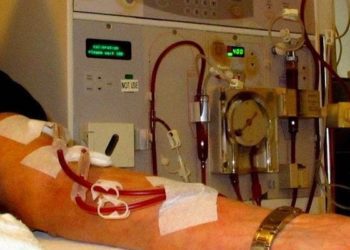MMF and rituximab combination effective in nephrotic syndrome
1. This retrospective analysis examined 24 children with steroid-resistant nephrotic syndrome, all initially treated with rituximab after failing traditional therapies (e.g. steroids, calcineurin inhibitors).
2. Children treated with both rituximab and mycophenolate mofetil (MMF) were more likely to have sustained complete remission of their nephrotic syndrome compared to those treated with rituximab alone.
Evidence Rating Level: 2 (Good)
Study Rundown: Idiopathic nephrotic syndrome in children is usually treated with steroids as first-line therapy, with approximately an 80% remission rate. The remaining 20% with steroid-resistant nephrotic syndrome are at especially high risk for poor renal function. In these children, various immunosuppressive agents (e.g. cyclophosphamide, calcineurin-inhibitors) are then tried as second line therapy, though these therapies are sometimes limited in efficacy and by a significant side effect profile. Therefore, a third class of therapy – rituximab – has recently gained ground. Rituximab, a monoclonal antibody targeting CD20 cells, works by depleting B lymphocytes. Children with steroid-resistant nephrotic syndrome achieving remission on rituximab still remain at risk for further relapse. As such, this study used MMF as an immunosuppressive agent to maintain induced remission by rituximab. Results indicated higher likelihood of maintaining remission when treated with both rituximab and MMF compared to rituximab alone. Limitations of this study include its retrospective nature, small sample size, and inability to follow MMF drug levels in establishing therapeutic efficacy.
Click to read the study, published today in Pediatrics
Relevant Reading: Kidney Disease: Improving Global Outcomes. Treatment of steroid-resistant nephrotic syndrome in children: new guidelines from KDIGO
In-Depth [retrospective analysis]: This study retrospectively examined 24 children between the ages of 2 and 16 years who have been diagnosed with idiopathic steroid-resistant nephrotic syndrome. Of the 24 children, 13 had minimal change disease and 11 had focal segmental glumerulosclerosis by histopathology. All children had initially received steroids and then calcineurin-inhibitors, without achieving sustained remission and/or experiencing significant side effects warranting cessation of therapy. Full remission was defined as normal urine protein to creatinine ratio of less than 0.2. Partial remission included urine protein to creatinine ratio of 0.2 to 2, serum albumin >2.5 g/dL, and no edema. These children initially all received rituximab, with course length dependent on achieving remission. Fifteen children were then started on MMF 3 months after receiving initial rituximab dose. At 6 months, 67% of those receiving MMF were in complete remission, while 33% were in partial remission. At 24 months, 33% of those receiving rituximab and MMF were in sustained complete remission (vs. 0% of children receiving rituximab alone), suggesting the effectiveness of adding MMF in steroid-resistant nephrotic syndrome. Of note, all children with sustained remission at 24 months had minimal change disease and were late steroid resistant, suggesting a possible favorable risk group.
Image: PD
©2015 2 Minute Medicine, Inc. All rights reserved. No works may be reproduced without expressed written consent from 2 Minute Medicine, Inc. Inquire about licensing here. No article should be construed as medical advice and is not intended as such by the authors or by 2 Minute Medicine, Inc.







